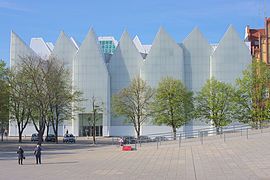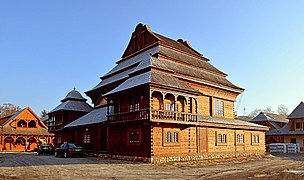Architecture of Poland
The architecture of Poland includes modern and historical monuments of architectural and historical importance.
Several important works of Western architecture, such as the Wawel Hill, the Książ and Malbork castles, cityscapes of Toruń, Zamość, and Kraków are located in the country. Some of them are UNESCO World Heritage Sites.[1] Now Poland is developing modernist approaches in design with architects like Daniel Libeskind, Karol Żurawski, and Krzysztof Ingarden.[2]
History
Pre-Romanesque and Romanesque architecture
The oldest, Pre-Romanesque buildings were built in Poland after the Christianisation of the country but only few of them still exist today (palace and church complex on Ostrów Lednicki, the Rotunda of the Blessed Virgin Mary in the Wawel Castle).
The Romanesque architecture was then developed in the 12th and 13th centuries. The most significant buildings are the second cathedral in Kraków (only parts of it still exist in the current, third, gothic cathedral, e.g. the crypt), Tum Collegiate Church, Czerwińsk abbey, collegiate churches in Kruszwica and Opatów as well as the churches of St. Andrew in Kraków and of Blessed Lady Mary in Inowrocław. Smaller structures were also popular, like rotundas in Cieszyn and Strzelno.
Late Romanesque architecture is represented by the Cistercian abbeys in Jędrzejów, Koprzywnica, Sulejów and Wąchock as well as the Dominican church in Sandomierz and the ruins of Legnica castle chapel.
- Rotunda of the Blessed Virgin Mary in the Wawel Castle
- The ruins of the palace and church complex on Ostrów Lednicki
- St. Leonard's Crypt in the Krakow Cathedral
- Collegiate Church in Kruszwica
- St. Andrew's Church in Kraków
- Rotunda in Cieszyn
- Rotunda in Strzelno
- Dominican church in Sandomierz
Gothic architecture
The first Gothic structures in Poland were built in the 13th century in Silesia. The most important churches from this time are the cathedral in Wrocław and the Collegiate Church of the Holy Cross and St Bartholomew in the same city, as well as the St Hedwig's Chapel in the Cistercian nuns abbey in Trzebnica and the castle chapel in Racibórz. The Gothic architecture in Silesia was further developed in the 14th century in the series of parish churches in the most important cities of the region (churches of St. Mary Magdalene, St. Elizabeth, St Mary on the Sand and St Dorothea in Wrocław, St. Nicholas' Church in Brzeg, Saints Stanislaus and Wenceslaus Church in Świdnica, Saints Peter and Paul church in Strzegom). The most important secular building of the gothic period in Silesia is the Wrocław Town Hall, initially built in the 13th century and enlarged and rebuilt in later centuries, mainly in the late 15th century.
The 14th century is also the heyday of the Gothic in Lesser Poland, where such structures were built like the gothic Wawel Cathedral in Kraków, the series of basilical churches in the same city (churches of St. Mary, Holy Trinity, Corpus Christi and St. Catherine) and many hall churches outside the capital city (e.g. Wiślica, Szydłów, Stopnica and Sandomierz). In the same time the Greater Poland's cathedrals in Poznań and Gniezno as well as the Latin Cathedral in Lviv (now Ukraine) were built.
Many Gothic structures were also built in Royal Prussia before and after the incorporation of the region into the Polish Crown according to the Second Peace of Thorn (1466). The most important sights are the castles of the Teutonic Order in Malbork, Gniew and Radzyń Chełmiński and the town halls and churches of Toruń (town hall, the churches of St. John the Baptist and St. John the Evangelist and St. James the Greater), Chełmno, Pelplin, Frombork and Gdańsk (town hall and churches of St. Mary, St. Catherine and Holy Trinity).
Late Gothic is represented by such buildings like the Collegium Maius of the Jagiellonian University in Krakow or the St. Mary's Church in Poznań and the Corpus Christi Church in Biecz. Moreover, in the 1st half of the 16th century diamond vaults were popular, especially in Masovia (St Michael's Church in Łomża, the cloister of the St. Anne's Church in Warsaw) and in Royal Prussia (eg. in the aforementioned churches of Gdańsk and in the St James’s Concathedral Basilica in Olsztyn).
There are also some examples of the post-Gothic architecture (germ. Nachgotik) from the 17th century, like the choir of the St. Hyacinth's Church in Warsaw or the Bernardine monastery in Przasnysz.
In the modern Poland there are also some examples of Gothic architecture of the former Duchy of Pomerania like the Kamień Pomorski Cathedral, Szczecin Cathedral and the St. Mary's Church in Stargard.
- Wrocław Cathedral (1244 - ca. 1350)
- Collegiate Church of the Holy Cross and St. Bartholomew in Wrocław (1288 - ca. 1350)
- Church of St. Mary on the Sand in Wrocław (2nd half of the 14th century)
- Wrocław Town Hall (13th century, ca. 1470-1510)
- Krakow Cathedral (1320–64)
- St. Mary's Basilica in Krakow (2nd half of the 14th century)
- St. Catherine's Church in Krakow (ca. 1340 - 15th century)
- Collegiate Church in Wiślica (ca. 1350-70)
- Poznań Cathedral (2nd half of the 14th century - ca. 1430)
- Gniezno Cathedral (2nd half of the 14th century)
- Malbork Castle (ca. 1280 - 15th century)
- Old Town City Hall in Toruń (1393–99)
- Church of Saint James the Greater in Toruń (1st half of the 14th century)
- Frombork Cathedral (ca. 1330-90)
- Gdańsk Town Hall (14th century - 15th century )
- St. Mary's Church in Gdańsk (1379-1502)
- Diamond vaults in the cloister of the St. Anne's Church in Warsaw (1514)
- Courtyard of the Collegium Maius of the Jagiellonian University in Krakow (ca. 1490-1540)
- Bernardine monastery in Przasnysz (1585-1618)
Renaissance
The Renaissance came to Poland as a court fashion thanks to King Sigismund, who became acquainted with this stylistics in Buda, at the court of his Hungarian uncle. Sigismund invited Italian craftsmen from Buda to Kraków, where they created the first Italian Renaissance piece in Poland, the Tomb of John I Albert in the Wawel Cathedral (between 1502 and 1506) and remodelled in the new manner the Wawel Castle. One of the masterpieces of this time is also the Sigismund's Chapel of the Wawel Cathedral.
Later, the Renaissance architecture was especially popular in the secular architecture and is represented by the cloth hall in Krakow, many town halls (e.g. in Poznań, Tarnów, Sandomierz and Chełmno), town houses on the market squares (e.g. in Zamość, Kazimierz Dolny, Lublin, Warsaw and Lviv) and castles (e.g. the Baranów Sandomierski Castle, Krasiczyn Castle and Krzyżtopór Castle).
In religious architecture Renaissance influences are visible in the Zamość Cathedral, in the church of St. Bartholomew and John the Baptist in Kazimierz Dolny, in the Bernardine churches of Lublin and Lviv (now Ukraine) as well as in many synagogues (e.g. the Old Synagogue in Krakow and Zamość Synagogue). Moreover, a specific group of churches, inspired by the Romanesque tradition of the region, was built in Mazovia (Płock, Pułtusk, Brochów, Brok). Late mannierism from the time of the Counter-Reformation is represented by the Kalwaria Zebrzydowska calvary complex.
The Renaissance architecture in the northern cities developed under the influence of Dutch Mannierism. The most important examples are the Great Armoury, Green Gate and Old Town City Hall in Gdańsk, as well as many town houses in Gdańsk, Toruń and Elbląg (e.g. Jost von Kampen house in Elbląg).
Within the borders of modern Poland are also some important Renaissance buildings built in the lands of the then Holy Roman Empire like the castle in Szczecin or the castle and the town hall in Brzeg as well as the church in Żórawina.
- Wawel Castle in Krakow (1507–36)
- Kraków Cloth Hall (1556–60)
- Poznań Town Hall (1550–60)
- Tarnów town hall (1560–70)
- Town houses on the market square in Zamość (2nd quarter of the 17th century)
- Town houses on the market square in Kazimierz Dolny (1615)
- Konopniców Townhouse in Lublin (1575)
- Krasiczyn Castle (1598-ca. 1620)
- Zamość Cathedral (1587-ca. 1600)
- Church of St. Bartholomew and John the Baptist in Kazimierz Dolny (1610–13)
- The Old Synagogue in Krakow (ca. 1560)
- Zamość Synagogue (1610–18)
- St. John the Baptist and St. Roch Church in Brochów (1551–61)
- One of the chapels in the Kalwaria Zebrzydowska calvary complex
- Great Armoury in Gdańsk (1600–05)
- Green Gate in Gdańsk (1565–68)
- Old Town City Hall in Gdańsk (1587–95)
Baroque architecture
The early Baroque in Poland was dominated by the Roman influences (the jesuite churches in Nesvizh, Krakow and Lviv, as well as the Camaldolese Monastery in Kraków). In the second half of the 17th century the influences of the Dutch Baroque architecture were also important thanks to the Tylman van Gameren (Krasiński Palace and St. Kazimierz Church in Warsaw, St. Anne's Church in Kraków, Royal Chapel in Gdańsk).
The most important structures of the Polish late Baroque were built in the former Eastern Borderlands, like the churches of St. Peter and St. Paul and St. Johns in Vilnius (now Lithuania), the St. George's Cathedral and the Dominican Church in Lviv (now Ukraine) as well as the Basilian Church and Monastery in Berezwecz (now Belarus) and the Saint Sophia Cathedral in Polotsk (now Belarus). Other key buildings of this period are the Piarists Church and the Church of the Conversion of St. Paul in Krakow, the Visitationist Church in Warsaw, the Greater Poland's abbeys in Głogówko near Gostyń and in Ląd as well as the Święta Lipka pilgrimage church in Warmia.
The secular Baroque architecture in Poland is represented by the Ujazdów Castle, Royal Castle and Wilanów Palace in Warsaw, Palace of the Kraków Bishops in Kielce as well as Branicki Palace in Białystok. Other important structures are also the palaces in Radzyń Podlaski, Rogalin and Rydzyna. In Royal Prussia the most important example is the Abbot's Palace in Oliwa (district of Gdańsk).
In modern Poland there are also important examples of the Baroque architecture in Silesia, which was then a part of the Habsburg monarchy. They include i.a. the main building of the University of Wrocław, the Protestant Churches of Peace in Świdnica and Jawor, the former Protestant (now Catholic) Exaltation of the Holy Cross Church in Jelenia Góra, the Cistercian monasteries in Lubiąż, Krzeszów and Henryków as well as the churches by Kilian Ignaz Dientzenhofer in Legnica (Church of St. John the Baptist built together with Christoph Dientzenhofer) and in Legnickie Pole.
- Saints Peter and Paul Church in Kraków (1597-1635)
- St. Kazimierz Church in Warsaw (1688–92)
- Royal Chapel in Gdańsk (1678–81)
- St. Anne's Church in Kraków (1689-1703)
- Church of St. Peter and St. Paul in Vilnius, now Lithuania (1668–76)
- Church of St. Johns in Vilnius, now Lithuania (ca. 1748)
- St. George's Cathedral in Lviv, now Ukraine (1744–62)
- Dominican Church in Lviv, now Ukraine (1744–69)
- Basilica on the Holy Mountain in Głogówko near Gostyń (1677–98)
- Kraków Bishops Palace in Kielce (1637–44)
- Royal Castle in Warsaw, main facade (1614–19)
- Royal Castle, eastern wing (1737–52)
- Wilanów Palace in Warsaw (1677–96, 1723–29)
- Branicki Palace in Białystok (1728–70)
Neoclassicism
Neoclassicism dominated Polish architecture during the second half of the 18th and first third of the 19th century as a manifestation of Enlightenment rationalism. New stylistics came from France, Italy, and partly from Germany as a reflection of general admiration only for the newly discovered Greco-Roman antiquity. The most important structures from this period are the palaces On the Isle and Królikarnia in Warsaw by Domenico Merlini, the Lutheran Holy Trinity Church in the same city by Szymon Bogumił Zug and the cathedral in Vilnius (now Lithuania) by Wawrzyniec Gucewicz.
Late neoclassicism, which was chronologically connected with the end of the Napoleonic Wars and capture of the former Duchy of Warsaw by the Russian Empire in 1815, was characterized by significant volumes of construction, large representative buildings, which set a new, large scale of squares and streets of Warsaw like the Saxon Palace. The leading architect of the late neoclassicism in Poland is Italian Antonio Corazzi. His main buildings in Warsaw include Staszic Palace, the buildings on the Bank Square and the Grand Theatre. Other important architects were Piotr Aigner (the palace and the pavilions in Puławy landscape garden, St. Alexander's Church in Warsaw, Presidential Palace) and Jakub Kubicki (Belvedere Palace in Warsaw).
Apart from Congress Poland, worth mentioning are also the Raczyński Library in Poznań (designed probably by Charles Percier and Pierre-François-Léonard Fontaine) and the Wybrzeże Theater in Gdańsk (after the World War II reconstructed in modern form).
- Królikarnia in Warsaw (by Domenico Merlini, 1782–86)
- Lutheran Holy Trinity Church in Warsaw (by Szymon Bogumił Zug, 1777–82)
- Vilnius Cathedral, now Lithuania (by Wawrzyniec Gucewicz, 1777-1801)
- Grand Theatre in Warsaw (by Antonio Corazzi, 1825–33)
- St. Alexander's Church in Warsaw (by Piotr Aigner, 1818–25)
- Belvedere Palace in Warsaw (by Jakub Kubicki, 1819–22)
- Raczyński Library in Poznań (probably by Charles Percier and Pierre-François-Léonard Fontaine, 1822–28)
Style revivals
The territory of the former Polish state remained divided between Prussia (Germany), Russia, and the Austrian (Austro-Hungarian) Empire and developed unevenly.
The architecture of Kraków and Galicia at that time was oriented towards the Viennese model. The experience of Vienna Ring Road was successfully applied in Kraków where Planty Park was created. Stylistically, it was an eclecticism dominated by Neo-Gothic (Collegium Novum of the Jagiellonian University) and Neo-Renaissance (Słowacki Theatre). Similar stylistics dominated also in Lviv (Lviv Opera, Lviv Polytechnic and the building of the Diet of Galicia and Lodomeria, now housing the University of Lviv), Warsaw (Warsaw Polytechnic, Zachęta National Gallery of Art, Bristol Hotel) and Łódź (Izrael Poznański Palace).
In the church architecture, the most important was Neo-Gothic, promoted by architects like Józef Pius Dziekoński (Karol Scheibler's Chapel in Łódź, St. Florian's Cathedral in Warsaw, Białystok Cathedral, Radom Cathedral), Konstanty Wojciechowski (Częstochowa Cathedral), Jan Sas-Zubrzycki (St. Joseph's Church in Krakow) and Teodor Talowski (Church of Sts. Olha and Elizabeth in Lviv, Church of St. Mary in Ternopil).
Apart from Polish architects, also some important German and Austrian architects were active in the partitioned Poland, e.g. Karl Friedrich Schinkel (St. Martin's Church in Krzeszowice, the Kórnik Castle, the Radziwiłł Palace in Antonin), Franz Schwechten (Imperial Castle in Poznań and the Lutheran Church in Łódź), Friedrich Hitzig (Kronenberg Palace in Warsaw, demolished in 1962), Theophil Hansen (House of military invalids in Lviv, now Ukraine), Heinrich von Ferstel (Lutheran Church in Bielsko Biała) and Fellner & Helmer (Goetz Palace in Brzesko, Hotel George and Noble Casino in Lviv, theaters in Bielsko-Biała, Cieszyn and Toruń).
Within the borders of the modern Poland are also important examples built in at the time Prussian Silesia and Prussian Pomerania, like the Chrobry Embankment (germ. Hakenterrasse) in Szczecin and the works of Karl Friedrich Schinkel (town hall in Kołobrzeg, Kamieniec Ząbkowicki Palace), Friedrich August Stüler (Royal Palace of Wrocław, St. Barbara's Church in Gliwice) and Alexis Langer (St. Mary's Church in Katowice, St. Michael Archangel's Church in Wrocław).
In the era of capitalism, many factory owners' villas and palaces are built, as well as numerous workers' housing estates and industrial buildings.
- Collegium Novum of the Jagiellonian University in Krakow (by Feliks Księżarski, 1873–87)
- Juliusz Słowacki Theatre in Krakow (by Jan Zawiejski, 1891–93)
- Lviv Opera, now Ukraine (by Zygmunt Gorgolewski, 1897-1900)
- Warsaw Polytechnic (by Stefan Szyller, 1899-01)
- Izrael Poznański Palace in Łódź (by Hilary Majewski and Juliusz Jung, 1888–1903)
- Karol Scheibler's Chapel in Łódź (by Edward Lilpop, Józef Pius Dziekoński, 1885–88)
- St. Florian's Cathedral in Warsaw (by Józef Pius Dziekoński, 1888-04)
- St. Joseph's Church in Krakow (by Jan Sas-Zubrzycki, 1905–09)
- Church of Sts. Olha and Elizabeth in Lviv, now Ukraine (by Teodor Talowski, 1903–11)
- St. Martin's Church in Krzeszowice (by Karl Friedrich Schinkel, 1824–44)
- Kórnik Castle (by Karl Friedrich Schinkel, 1843–58)
- Nowy Sącz Town Hall (by Jan Peroś, 1897)
- Imperial Castle in Poznań (by Franz Schwechten, 1905–10)
- Grand Hotel Lublinianka (by Gustaw Landau, 1899)
- Wilam Horzyca Theater in Toruń (by Fellner & Helmer, 1903–04)
- St. Mary's Church in Katowice (by Alexis Langer, 1862–79)
- St. Michael Archangel's Church in Wrocław (by Alexis Langer, 1862–71)
- Chrobry Embankment (germ. Hakenterrasse) in Szczecin
Art Nouveau and Folk Architecture
Art Nouveau emerged as an attempt to abandon stylization and eclecticism, invent a new architectural style that would meet the spirit of the time. The most important centre of this style was Galicia, where many buildings were built under the influence of the Vienna Secession. The most important architects were Franciszek Mączyński in Krakow (Palace of Art, House Under the Globe, Basilica of the Sacred Heart of Jesus) and Władysław Sadłowski in Lviv (Lviv railway station, Lviv's Philharmonic, Industrial School). Moreover, in Krakow important are also the interiors designed by Stanisław Wyspiański in the House of the Krakow Medical Society and by Józef Mehoffer in the House Under the Globe.
In Bielsko-Biała some architects direct from Vienna were active, like Leopold Bauer (Saint Nicholas' Cathedral, house at 51 Stojałowskiego Street) and Max Fabiani (house at 1 Barlickiego Street). Other important examples in the city include also the so-called Frog House.
In Congress Poland the Art Nouveau is represented by e.g. the Leopold Kindermann's Villa and the Poznanski's Mausoleum in Łódź, the bank building at 47 Sienkiewicza Street in Kielce and the early-modernist Eagles House in Warsaw.
Polish architects from the 1890s were also discovering folk motives. The leading figure of this trend was Stanisław Witkiewicz, the founder of the Zakopane Style. Folk-inspired were also many World War I Eastern Front cemeteries in Galicia, many of them designed by Dušan Jurkovič.
- Palace of Art in Krakow (by Franciszek Mączyński, 1898-01)
- House Under the Globe in Krakow (by Franciszek Mączyński and Tadeusz Stryjeński, 1904–05)
- House Under the Globe in Kraków - interior by Józef Mehoffer
- Basilica of the Sacred Heart of Jesus in Krakow (by Franciszek Mączyński, 1907–21)
- Lviv railway station, now Ukraine (by Władysław Sadłowski, 1899-04)
- Lviv's Philharmonic, now Ukraine (by Władysław Sadłowski, 1905–08)
- Saint Nicholas' Cathedral in Bielsko-Biała (by Leopold Bauer, 1909–10)
- Frog House in Bielsko-Biała (by Emanuel Rost, 1903)
- Leopold Kindermann's Villa in Łódź (by Gustaw Landau-Gutenteger, 1903)
- Poznanski's Mausoleum in Łódź (by Adolf Zeligson, 1901–03)
- Eagles House in Warsaw (by Jan Fryderyk Heurich, 1912–17)
- Villa Oksza in Zakopane (by Stanisław Witkiewicz, 1894–95)
- Villa Pod Jedlami in Zakopane (by Stanisław Witkiewicz, 1897)
- Chapel in Jaszczurówka, Zakopane (by Stanisław Witkiewicz, 1904–07)
- Chapel in the World War I Eastern Front Cemetery No. 123 in Łużna – Pustki (by Dušan Jurkovič, 1915)
- The World War I Eastern Front Cemetery 51 in Regietów (by Dušan Jurkovič, 1915)
Modern architecture
Interwar period
Poland's regaining of independence marked a new era in art, where modern architecture developed on a large scale, in the beginning often combining achievements of functionalism with elements of classicism. The most important architects of this period are Adolf Szyszko-Bohusz (PKO BP Building on Wielopole Street in Krakow), Marian Lalewicz (Polish Geological Institute in Warsaw, Bank Building at 50 Nowogrodzka Street in Warsaw, PKP Polskie Linie Kolejowe headquarters in Targowa Street in Warsaw), Bohdan Pniewski (Patria guesthouse in Krynica-Zdrój, court at 127 Solidarności Avenue in Warsaw) and Wacław Krzyżanowski (AGH University of Science and Technology, Jagiellonian Library in Krakow). Other important examples include also the buildings of the Polish Parliament (Sejm) in Warsaw and the Silesian Parliament in Katowice.
Important were also influences of the Polish folk art and the Expressionist architecture, clearly visible in the works of Jan Koszczyc Witkiewicz (e.g. Warsaw School of Economics), in the Polish pavilion at International Exhibition in Paris (1925) or in the St. Roch's Church in Białystok, as well as in the inspired by the Chilehaus house at 6 Inwalidów Square in Kraków.
Examples of Polish constructivism and international style include numerous housing complexes and modern residential houses built by architects Barbara Brukalska and Stanisław Brukalski (own house at 8 Niegolewskiego Street in Warsaw, WSM housing estate in Żoliborz, Warsaw), Bohdan Lachert (own house at 9 Katowicka Street in Warsaw), Józef Szanajca, Helena and Szymon Syrkus (WSM housing estate in Rakowiec, Warsaw) or Juliusz Żórawski (houses at 28 Puławska Street, 3 Przyjaciół Avenue and 34/36 Mickiewicza Street, Warsaw).
Construction investments took place on a larger scale in modern cities like seaport Gdynia, Katowice, and Stalowa Wola. The most important examples include in Gdynia the BGK housing complex as well as the buildings of the ZUS and the Department of Nautical Science of the Gdynia Maritime University and in Katowice the buildings of the former Silesian Parliament and the Silesian Museum (destroyed in World War II) as well as the so-called Skyscraper. Other early skyscrapers include the Prudential House in Warsaw.
- PKO BP Bank Building on Wielopole Street, Kraków (by Adolf Szyszko-Bohusz, 1922–25)
- PKP Polskie Linie Kolejowe headquarters in Targowa Street in Warsaw (by Marian Lalewicz, 1928–31)
- Jagiellonian Library in Krakow (by Wacław Krzyżanowski, 1929–39)
- Warsaw School of Economics (by Jan Koszczyc Witkiewicz, 1926–55)
- St. Roch's Church in Białystok (by Oskar Sosnowski, 1927–46)
- Brukalskis' own house at 8 Niegolewskiego Street in Warsaw (by Barbara and Stanisław Brukalski, 1927–29)
- Bohdan Lachert's own house at 9 Katowicka Street in Warsaw (by Bohdan Lachert and Józef Szanajca, 1928–29)
- WSM housing estate in Żoliborz, Warsaw
- WSM housing estate in Rakowiec, Warsaw (by Helena and Szymon Syrkus, 1934–38)
- House at 34/36 Mickiewicza Street in Warsaw, the so-called "Glass House" (by Juliusz Żórawski, 1938–41)
- Department of Nautical Science of the Gdynia Maritime University (by Bohdan Damięcki and Tadeusz Sieczkowski, 1937–39)
- Former Silesian Parliament in Katowice (by Ludwik Wojtyczko, 1925–29)
- Skyscraper in Katowice (by Tadeusz Kozłowski and Stefan Bryła, 1929–34)
- Prudential House in Warsaw (by Marcin Weinfeld and Stefan Bryła, 1931–33)
German modernism
Famous examples in modern Poland also include the works of German architects in Silesia, like Hans Poelzig (office building at 38-40 Ofiar Oświęcimskich Street and the Four Domes Pavilion in Wrocław), Max Berg (Centennial Hall in Wrocław), Dominikus Böhm (St Joseph's Church, Zabrze), Erich Mendelsohn (Jewish Tahara house in Olsztyn, department stores in Gliwice and Wrocław) or Hans Scharoun (the Ledigenheim at WUWA housing estate in Wrocław).
In the former Free City of Danzig Brick expressionist architecture gained popularity, represented by such works like the building of the health insurance company in the 27 Wałowa Street.
There are also some buildings built in the Nazi Germany or during the German occupation of Poland in the General Government like the Regierungspräsidium in Wrocław (now the headquarters of the Lower Silesian Voivodeship Sejmik) or the Przegorzały Castle (germ. Schloss Wartenberg) in Kraków.
- Office building at 38-40 Ofiar Oświęcimskich Street in Wrocław (by Hans Poelzig, 1912–13)
- Four Domes Pavilion in Wrocław (by Hans Poelzig, 1912–13)
- Centennial Hall in Wrocław (by Max Berg, 1911–13)
- St Joseph's Church in Zabrze (by Dominikus Böhm, 1930–31)
- Tahara house in Olsztyn (by Erich Mendelsohn, 1911–12)
- Weichmann Department Store in Gliwice (by Erich Mendelsohn, 1921–22)
- Petersdorff Department Store in Wrocław (by Erich Mendelsohn, 1927–28)
- Ledigenheim at WUWA housing estate in Wrocław (by Hans Scharoun, 1929)
- Former Regierungspräsidium (now the headquarters of the Lower Silesian Voivodeship Sejmik) in Wrocław (by Felix Bräuler, Erich Böddicker, Arthur Reck, 1939–45)
- Przegorzały Castle (germ. Schloss Wartenberg) in Kraków (by Adolf Szyszko-Bohusz, Richard Pfob, Hans Petermair, 1941–43)
After 1945
Reconstruction of cities and monuments after the war had a diverse character. Valuable examples of cultural restitution can be reconstructions of the old towns in Warsaw and Gdańsk. However, reconstruction of buildings in the Recovered Territories was strongly influenced by political aims of eradicating architecture perceived as German, and Prussian in particular.[3]
After the Second World War, the avant-garde architecture was initially developed (Central Department Store in Warsaw, Okrąglak Department Store in Poznań, Central Statistical Office building in Warsaw), but in the years 1949-1956 it was interrupted by the socialist realist period. The best examples of the so-called Stalinist neoclassicism are the Palace of Culture and Science by Lev Rudnev and the Marszałkowska Dzielnica Mieszkaniowa housing estate in Warsaw as well as the planned city of Nowa Huta (initially an independent city, now part of Krakow).
After the period of the socialist realism the architects could again develop the international style. The most important sights include the Biprocemwap Building, the Kijów Cinema and the Cracovia Hotel in Kraków, Ściana Wschodnia in Warsaw, railway stations in Warsaw (Centralna, Ochota, Śródmieście, Powiśle, Stadion, Wschodnia), Spodek in Katowice and the Church of Divine Mercy in Kalisz.
The brutalist architecture is represented by the Plac Grunwaldzki housing estate in Wrocław, the Bunkier Sztuki Gallery of Contemporary Art, the Arka Pana Church and the former Hotel Forum in Kraków, the "hammer" (młotek) building at 8 Smolna Street in Warsaw, the complex of sanatoriums in Ustroń as well as being inspired by Unité d'habitation residential unit Superjednostka and the railway station (demolished and partially rebuilt in 2010-12) in Katowice.
In the time of the People's Republic many new housing estates were built, some of them are distunguished by interesting architectural forms. Besides the above-mentioned Nowa Huta in Kraków and the Plac Grunwaldzki in Wrocław, also e.g. the Koło II in Warsaw by Helena and Szymon Syrkus, the Osiedle Za Żelazną Bramą in Warsaw, the Falowiec in Gdańsk, the Osiedle Tysiąclecia in Katowice as well as the housing estates Przyczółek Grochowski (Warsaw) and Osiedle Słowackiego (Lublin) by Oskar Nikolai Hansen and Zofia Garlińska-Hansen.
- Central Department Store in Warsaw (by Zbigniew Ihnatowicz and Jerzy Romański, 1948–52)
- Okrąglak Department Store in Poznań (by Marek Leykam, 1948–54)
- Palace of Culture and Science in Warsaw (by Lev Rudnev, 1952–55)
- Marszałkowska Dzielnica Mieszkaniowa in Warsaw (by Stanisław Jankowski, Jan Knothe, Józef Sigalin and Zygmunt Stępiński, 1950–52)
- Plac Centralny in Nowa Huta in Krakow (by Tadeusz Ptaszycki, Janusz and Marta Ingarden et al., 1952–55)
- Kijów Cinema (foreground) and the Cracovia Hotel (background) in Krakow (by Witold Cęckiewicz, 1960–67)
- Warszawa Centralna railway station (by Arseniusz Romanowicz and Piotr Szymaniak, 1972–75)
- Spodek in Katowice (by Maciej Gintowt, Maciej Krasiński, 1964–71)
- Bunkier Sztuki Gallery of Contemporary Art in Krakow (by Krystyna Różyska-Tołłoczko, 1959–65)
- "Arka Pana" Church in Kraków (by Wojciech Pietrzyk, 1965–77)
- Forum Hotel in Kraków (by Janusz Ingarden, 1978–89)
- Superjednostka residential unit in Katowice (by Mieczysław Król, 1967–72)
- Koło II housing estate in Warsaw (by Helena and Szymon Syrkus, 1947–50)
- Za Żelazną Bramą housing estate in Warsaw (by Jerzy Czyż, Jan Furman, Andrzej Skopiński, Jerzy Józefowicz, Marek Bieniewski and Stanisław Furman, 1965–72)
- Tysiąclecia housing estate in Katowice (by Henryk Buszko, Aleksander Franta, Marian Dziewoński and Tadeusz Szewczyk, 1961–82)
- Plac Grunwaldzki housing estate in Wrocław (by Jadwiga Grabowska-Hawrylak, 1970–73)
After 1989
Among the most important contemporary polish architects are the post-modernists Marek Budzyński (Warsaw University Library, the Supreme Court[4]), Romuald Loegler (Centrum E housing estate in Kraków and the chapel in the Batowice Cemetery in the same city) and Dariusz Kozłowski (Seminary of the Salesian Society in Krakow) as well as the neo-modernists Stefan Kuryłowicz (The Focus building in Warsaw), JEMS (Agora headquarters in Warsaw), Krzysztof Ingarden (Wyspiański Pavilion in Krakow) and Zbigniew Maćków (Silver Tower Center in Wrocław). One of the recent phenomeons are also many new museums built in last years, e.g. the Museum of the History of Polish Jews in Warsaw, the Museum of Taduesz Kantor in Kraków (Ośrodek Dokumentacji Sztuki Tadeusza Kantora Cricoteka), the Museum of the Solidarity and the Museum of the Second World War in Gdańsk as well as the concert halls, e.g. National Forum of Music in Wrocław and Szczecin Philharmonic.
After the creation of the Third Republic, starchitects Arata Isozaki (Manggha), Norman Foster (Metropolitan, Varso), Daniel Libeskind (Złota 44) and Helmut Jahn (Cosmopolitan Twarda 2/4) had their projects in Poland. Other foreign architects active in Poland are Larry Oltmanns/SOM (Rondo 1), Jürgen Mayer (Hotel Park Inn in Kraków), Rainer Mahlamäki (Museum of the History of Polish Jews), Renato Rizzi (Shakespearian Theatre in Gdańsk), Riegler Riewe Architekten (Silesian Museum), Estudio Barozzi Veig Studio (Szczecin Philharmonic) and MVRDV (Bałtyk in Poznań).
In 2015, Szczecin Philharmonic was awarded the European Union Prize for Contemporary Architecture.[5]
- Warsaw University Library (by Marek Budzyński and Zbigniew Badowski, 1994–98)
- Supreme Court of Poland in Warsaw (by Marek Budzyński and Zbigniew Badowski, 1996–99)
- Seminary of the Salesian Society in Krakow (by Dariusz Kozłowski, 1985–96)
- The Focus building in Warsaw (by Stefan Kuryłowicz, 1998-2001)
- Agora headquarters in Warsaw (by JEMS, 2000–02)
- Wyspiański Pavilion in Krakow (by Krzysztof Ingarden, 2006–07)
- POLIN Museum of the History of Polish Jews in Warsaw (by Rainer Mahlamäki, 2009–13)
- Ośrodek Dokumentacji Sztuki Tadeusza Kantora Cricoteka in Kraków (by Wizja and nsMoonStudio, 2009–14)
- Museum of the Second World War in Gdańsk (by Kwadrat architectural studio, 2010–17)
- Manggha Museum in Krakow (by Arata Isozaki, 1993–94)
- Metropolitan in Warsaw (by Norman Foster, 2001–03)
- Varso Tower in Warsaw (by Norman Foster, 2016–22)
- Złota 44 in Warsaw (by Daniel Libeskind, 2008–13)
- Cosmopolitan Twarda 2/4 in Warsaw (by Helmut Jahn, 2010–14)
- Szczecin Philharmonic (by Estudio Barozzi Veiga, 2011–14)
Vernacular architecture
Vernacular architecture of Poland includes many wooden Roman Catholic churches and tserkvas (Orthodox and Eastern Catholic churches) in the southeastern Carpathians, some of them dating from the 14th and 15th century (eg. churches of the Assumption of Holy Mary Church in Haczów, of the St. Michael Archangel in Dębno, of the All Saints in Blizne and of the St. Leonard in Lipnica Murowana). Other examples include wooden synagogues of the Polish–Lithuanian Commonwealth, however most of them were destroyed during the World War II.
- Church of the Assumption of Holy Mary in Haczów
- Tserkva of Mother of God in Chotyniec
- Reconstruction of the Połaniec synagogue in the Museum of Folk Architecture in Sanok
- Reconstruction of the Wołpa Synagogue in Biłgoraj
Architecture schools in Poland
| Part of a series on the |
| Culture of Poland |
|---|
 |
| Traditions |
| Mythology |
| Cuisine |
| Festivals |
| Religion |
| University | Department | Location |
|---|---|---|
| Politechnika Gdańska | Wydział Architektury | Gdańsk |
| Politechnika Poznańska | Wydział Architektury | Poznań |
| Politechnika Wrocławska | Wydział Architektury | Wrocław |
| Politechnika Warszawska | Wydział Architektury | Warsaw |
| Politechnika Śląska | Wydział Architektury Politechniki Śląskiej | Gliwice |
| Politechnika Rzeszowska | Wydział Budownictwa, Inżynierii Środowiska i Architektury | Rzeszów |
| Politechnika Krakowska | Wydział Architektury | Kraków |
| Politechnika Lubelska | Wydział Budownictwa i Architektury | Lublin |
| Politechnika Łódzka | Instytut Architektury i Urbanistyki
Wydziału Budownictwa, Architektury i Inżynierii Środowiska PŁ |
Łódź |
| Politechnika Białostocka | Wydział Architektury | Białystok |
| Uniwersytet Artystyczny w Poznaniu | Wydział Architektury i Wzornictwa | Poznań |
| Uniwersytet Technologiczno-Przyrodniczy w Bydgoszczy | Wydział Budownictwa, Architektury i Inżynierii Środowiska | Bydgoszcz |
| Zachodniopomorski Uniwersytet Technologiczny w Szczecinie | Wydział Budownictwa i Architektury | Szczecin |
| Politechnika Świętokrzyska | Wydział Budownictwa i Architektury | Kielce |
| Państwowa Wyższa Szkoła Zawodowa | Instytut Architektury | Racibórz |
| Państwowa Wyższa Szkoła Zawodowa | Wydział Nauk Technicznych | Nysa |
| Państwowa Wyższa Szkoła Zawodowa | Instytut Nauk Technicznych | Nowy Targ |
Literature and sources
- Tadeusz Dobrowolski, Sztuka polska, Warszawa 1970.
- Tadeusz Dobrowolski, Władysław Tatarkiewicz (ed.), Historia sztuki polskiej vol. I-III, Kraków 1965.
- Marek Walczak, Piotr Krasny, Stefania Kszysztofowicz-Kozakowska, Sztuka Polski, Kraków 2006.
- Adam Miłobędzki, Zarys dziejów architektury w Polsce, Warszawa 1978.
- Zygmunt Świechowski, Sztuka polska. Romanizm, Warszawa 2005.
- Szczęsny Skibiński, Katarzyna Zalewska-Lorkiewicz, Sztuka polska. Gotyk, Warszawa 2010.
- Mieczysław Zlat, Sztuka polska. Renesans i manieryzm, Warszawa 2008.
- Zbigniew Bania [et al.], Sztuka polska. Wczesny i dojrzały barok (XVII wiek), Warszawa 2013.
- Zbigniew Bania [et al.], Sztuka polska. Późny barok, rokoko, klasycyzm (XVIII wiek), Warszawa 2016.
- Jerzy Malinowski [ed.], Sztuka polska. Sztuka XIX wieku (z uzupełnieniem o sztukę Śląska i Pomorza Zachodniego), Warszawa 2016.
- Stefania Krzysztofowicz-Kozakowska, Sztuka II RP, Olszanica 2013.
- Stefania Krzysztofowicz-Kozakowska, Sztuka w czasach PRL, Olszanica 2016.
- Stefania Krzysztofowicz-Kozakowska, Sztuka od roku 1989, Olszanica 2020.
- Anna Cymer, Architektura w Polsce 1945–1989, Warszawa 2019.
See also
- List of Polish architects
- Architecture of Warsaw
- Residential architecture in Poland
- List of tallest buildings in Poland
- Wooden synagogues of the former Polish–Lithuanian Commonwealth
- Vernacular architecture of the Carpathians
- Silesian architecture
- Association of Polish Architects
References
- ^ "Poland". UNESCO World Heritage Centre. Retrieved 2020-05-30.
- ^ "A Foreigner's Guide to Polish Architecture". Culture.pl. Retrieved 2020-05-30.
- ^ Julia Roos (2010). Denkmalpflege Und Wiederaufbau Im Nachkriegspolen: Die Beispiele Stettin Und Lublin. Diplomica Verlag. p. 61.
- ^ "Marek Budzyński". Culture.pl. Retrieved 2020-05-30.
- ^ Anonymous (2015-05-08). "Winner of EU Prize for Contemporary Architecture - Mies van der Rohe Award announced". Creative Europe - European Commission. Retrieved 2020-05-30.
External links
 Media related to Architecture of Poland at Wikimedia Commons
Media related to Architecture of Poland at Wikimedia Commons













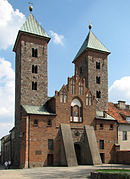
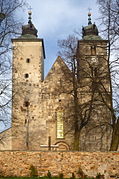












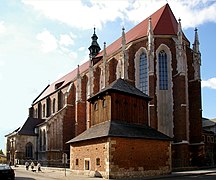












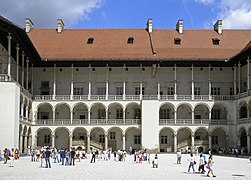

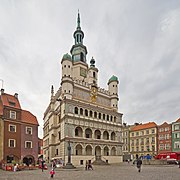

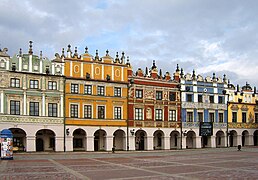










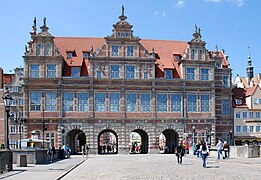




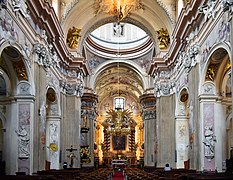
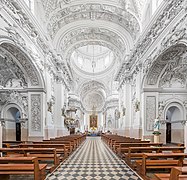


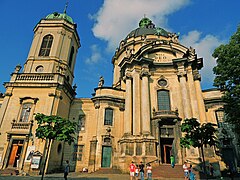


















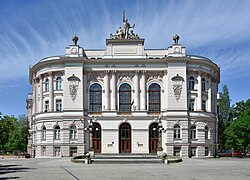

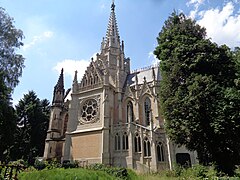





















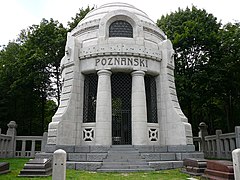



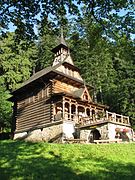





















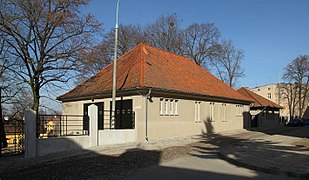



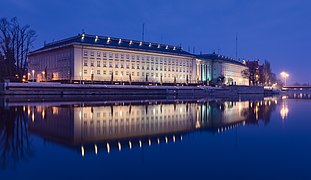














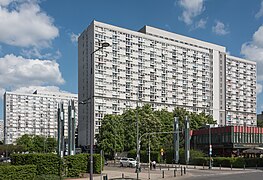

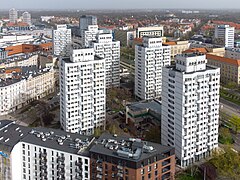



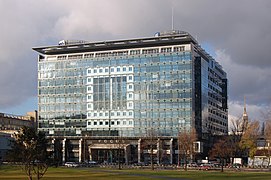



![Ośrodek Dokumentacji Sztuki Tadeusza Kantora Cricoteka [pl] in Kraków (by Wizja and nsMoonStudio, 2009–14)](https://upload.wikimedia.org/wikipedia/commons/thumb/6/66/20200826_Cricoteka_w_Krakowie_1819_1345.jpg/271px-20200826_Cricoteka_w_Krakowie_1819_1345.jpg)






